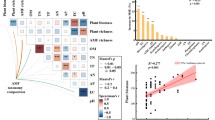Abstract
The change in dried rhizome samples that were left to decompose was investigated to elucidate the effects of rhizome age on the decomposition rate of Phragmites australis. Rhizomes were classified into five age categories and placed 30 cm below the soil surface of a reed stand. After 369 days of decay, new (i.e., aged less than one year) rhizomes had lost 84% of their original dry mass, compared with a loss of 41–62% for that of older rhizomes. The exponential decay rates of older rhizomes were nearly identical to that of aboveground biomass. The nitrogen (N) concentration increased to two times its original values, but the phosphorus (P) concentration remained constant after an initial loss by leaching. The carbon to nitrogen (C:N) and carbon to phosphorus ratios (C:P) leveled out at 22:1 to 38:1 and 828:1 to 1431:1, respectively, regardless of rhizome age. The results are important to understand the nutrient cycles of reed-dominant marsh ecosystems.
Similar content being viewed by others
References
Andersen, F. Ø., 1978. Effects of nutrient level on the decomposition of Phragmites communis Trin. Arch. Hydrobiol. 84(1): 42–54.
Čížková, H. & V. Bauer, 1998. Rhizome respiration of Phragmites australis: effect of rhizome age, temperature and nutrient status of the habitat. Aquat. Bot. 61: 239–253.
Fiala, K., 1976. Underground organs of Phragmites communis, their growth, biomass and net production. Folia Geobot. Phytotax. 11: 225–259.
Hasegawa, K., 1993. Analysis of Food. Baifukan Publisher, Tokyo, 179 pp. (in Japanese).
Haslam, S. M., 1970. The development of the annual population in Phragmites communis. Ann. Bot. 34: 571–591.
Jørgensen, S. E., S. N. Nielsen & L. A. Jørgensen, 1991. Handbook of Ecological Parameters and Ecotoxicology. Elsevier, Amsterdam: 1263 pp.
Larsen, V. J. & H.-H. Schierup, 1981. Macrophyte cycling of zinc, copper, lead and cadmium in the littoral zone of a polluted and a non-polluted lake. II. Seasonal changes in heavy metal content of above-ground biomass and decomposing leaves of Phragmites australis (Cav.) Trin. Aquat. Bot. 11: 211–230.
Parnas, H., 1975. Model for decomposition of organic material by microorganisms. Soil Biol. Biochem. 7: 161–169.
Polunin, N. V. C., 1982. Processes contributing to the decay of reed (Phragmites australis) litter in freshwater. Arch. Hydrobiol. 94: 182–209.
Polunin, N. V. C., 1984. The decomposition of emerged macrophytes in freshwater. Adv. ecol. Res. 14: 115–166.
Silver, W. L. & R. Miya, 2001. Global patterns in root decomposition: comparisons of climate and litter quality effects. Oecologia 129: 407–419.
van der Valk, A. G. & P. M. Attwill, 1983. Above-and below-ground litter decomposition in an Australian salt marsh. Aust. J. Ecol. 8: 441–447.
Wrubleski, D. A., H. R. Murkin, A. G. van der Valk & J. W. Nelson, 1997. Decomposition of emergent macrophyte roots and rhizomes in a northern prairie marsh. Aquat. Bot. 58: 121–134.
Author information
Authors and Affiliations
Rights and permissions
About this article
Cite this article
Asaeda, T., Nam, L.H. Effects of rhizome age on the decomposition rate of Phragmites australis rhizomes. Hydrobiologia 485, 205–208 (2002). https://doi.org/10.1023/A:1021314203532
Issue Date:
DOI: https://doi.org/10.1023/A:1021314203532




